Higher classification Leopardus | Phylum Chordata Scientific name Leopardus wiedii Rank Species | |
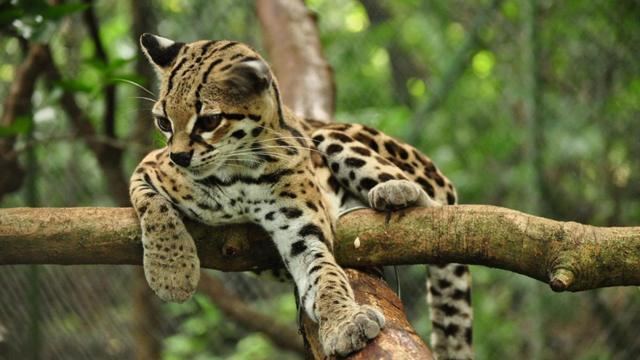 | ||
Similar Leopardus, Ocelot, Jaguarundi, Oncilla, Serval | ||
Margay
The margay (Leopardus wiedii) is a small cat native to Central and South America that is listed as Near Threatened by the IUCN since 2008 because remaining populations are thought to be declining due to loss of habitat following conversion of forests.
Contents
- Margay
- Margay project video
- Characteristics
- Distribution and habitat
- Behavior and ecology
- Diet
- Reproduction and lifecycle
- Subspecies
- References
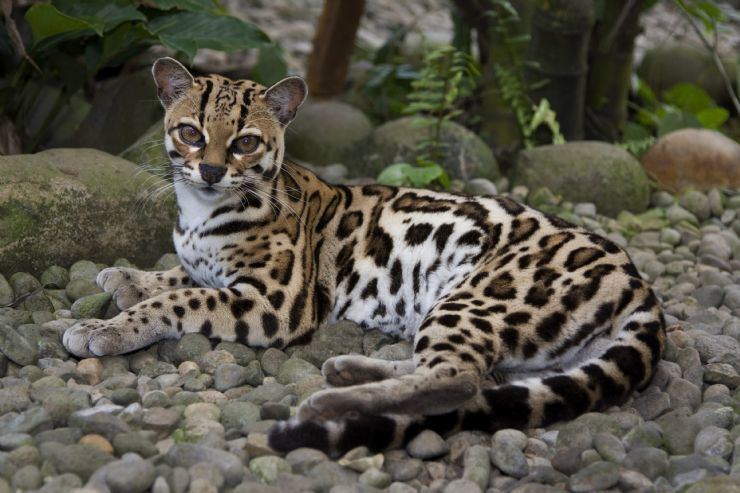
In his first description, Schinz named the margay Felis wiedii in honour of Prince Maximilian of Wied-Neuwied who collected specimens in Brazil.
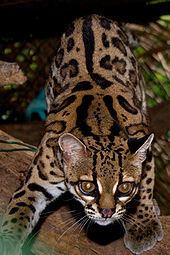
The margay is a solitary and nocturnal cat. It lives foremost in primary evergreen and deciduous forest. Until the 1990s margays were hunted illegally for the wildlife trade, which resulted in a large population decrease.
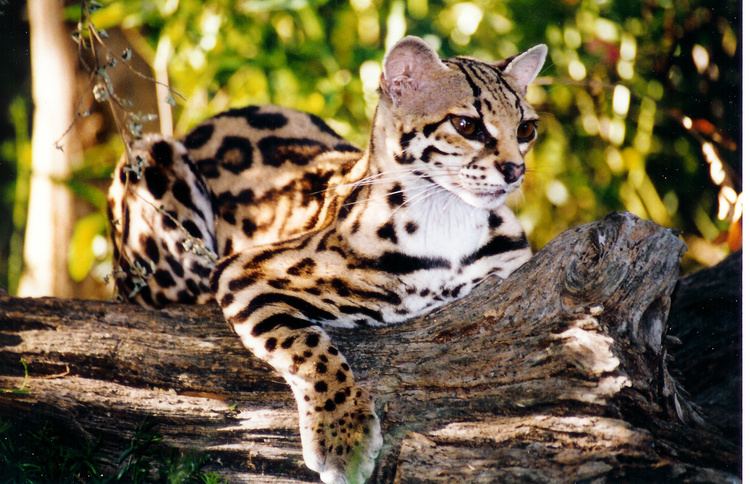
Margay project video
Characteristics
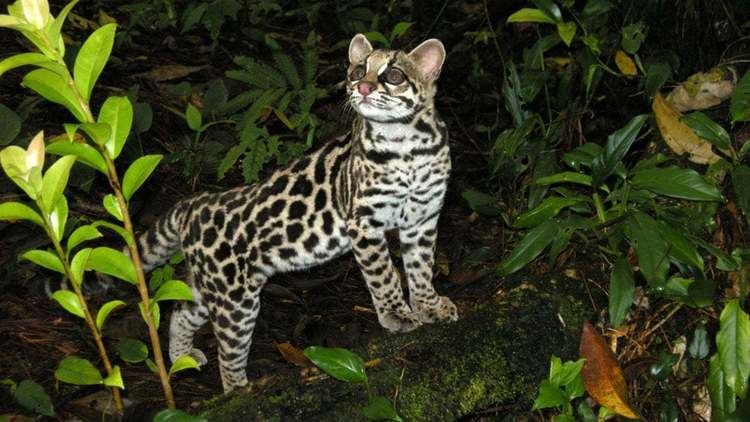
The margay is very similar to the larger ocelot in appearance, although the head is a little shorter, the eyes larger, and the tail and legs longer. It weighs from 2.6 to 4 kilograms (5.7 to 8.8 lb), with a body length of 48 to 79 centimetres (19 to 31 in), and a tail length of 33 to 51 centimetres (13 to 20 in). Unlike most other cats, the female possesses only two teats.
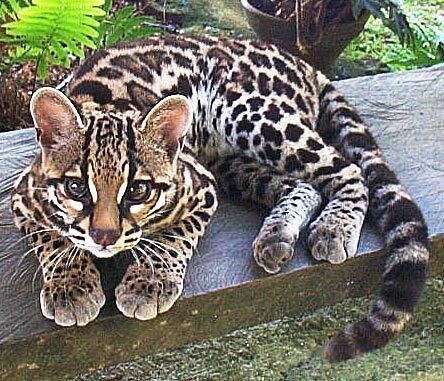
The fur is brown and marked with numerous rows of dark brown or black rosettes and longitudinal streaks. The undersides are paler, ranging from buff to white, and the tail has numerous dark bands and a black tip. The backs of the ears are black with circular white markings in the centre.
Most notably the margay is a much more skillful climber than its relative, and it is sometimes called the tree ocelot because of this ability. Whereas the ocelot mostly pursues prey on the ground, the margay may spend its entire life in the trees, leaping after and chasing birds and monkeys through the treetops. Indeed, it is one of only two cat species with the ankle flexibility necessary to climb head-first down trees (the other being the clouded leopard although the poorly studied marbled cat may also have this ability). It is remarkably agile; its ankles can turn up to 180 degrees, it can grasp branches equally well with its fore and hind paws, and it is able to jump up to 12 feet (3.7 m) horizontally. The margay has been observed to hang from branches with only one foot. Its look is also similar to the oncilla.
Distribution and habitat
The margay is found from southern Mexico, through Central America and in northern South America east of the Andes. The southern edge of its range reaches Uruguay and northern Argentina. They are found almost exclusively in areas of dense forest, ranging from tropical evergreen forest to tropical dry forest and high cloud forest. Margays have sometimes also been observed in coffee and cocoa plantations.
Fossil evidence of margays or margay-like cats has been found in Florida and Georgia dating to the Pleistocene, suggesting that they had a wider distribution in the past. The last record from Texas was from 1852.
Behavior and ecology
While margays are nocturnal, in some areas they have also been observed to hunt during the day. They prefer to spend most of their life in the trees, but also travel across the ground, especially when moving between hunting areas. During the day, they rest in relatively inaccessible branches or clumps of lianas.
Like most cats, they are solitary, with the adults only commonly meeting to mate. They are sparsely distributed even within their natural environment, occupying relatively large home ranges of 11 to 16 square kilometres (4.2 to 6.2 sq mi). They use scent marking to indicate their territory, including urine spraying and leaving scratch marks on the ground or on branches. Their vocalisations all appear to be short range; they do not call to each other over long distances.
Margays have recently been discovered to hunt by mimicking the vocalisation of a prey species, pied tamarin (Saguinus bicolor), which has been compared by scientists to tool-use by monkeys.
Diet
Because the margay is mostly nocturnal and is naturally rare in its environment, most dietary studies have been based on stomach contents and faecal analysis. This cat hunts small mammals, including monkeys, and birds, eggs, lizards and tree frogs. It also eats grass and other vegetation, most likely to help digestion. A 2006 report about a margay chasing squirrels in its natural environment confirmed that the margay is able to hunt its prey entirely in trees. However, margays do sometimes hunt on the ground, and have been reported to eat terrestrial prey, such as cane rats and guinea pigs.
There has been one report of a margay using auditory mimicry to try to lure one of its prey. A margay was observed to imitate the call of a pied tamarin infant while in the presence of a group of adult tamarins, leading the adults to investigate. While the margay was not successful in catching one of the monkeys, this represents the first observation of a Neotropical predator employing this type of mimicry.
Reproduction and lifecycle
Female margays are in estrus for four to ten days over a cycle of 32 to 36 days, during which they attract males with a long, moaning call. The male responds by yelping or making trilling sounds, and also by rapidly shaking his head from side to side, a behavior not seen in any other cat species. Copulation lasts up to sixty seconds, and is similar to that in domestic cats; it takes place primarily in the trees, and occurs several times while the female is in heat.
Gestation lasts about 80 days, and generally results in the birth of a single kitten (very rarely, there are two) usually between March and June. Kittens weigh 85 to 170 grams (3.0 to 6.0 oz) at birth. This is relatively large for a small cat, and is probably related to the long gestation period. The kittens open their eyes at around two weeks of age, and begin to take solid food at seven to eight weeks. Margays reach sexual maturity at twelve to eighteen months of age, and have been reported to live up to twenty-four years in captivity.
Infants suffer from a 50% mortality rate. Coupled with the problems they have breeding in captivity, this makes the prospect of increasing the population very difficult.
Subspecies
These are the currently recognized subspecies:
